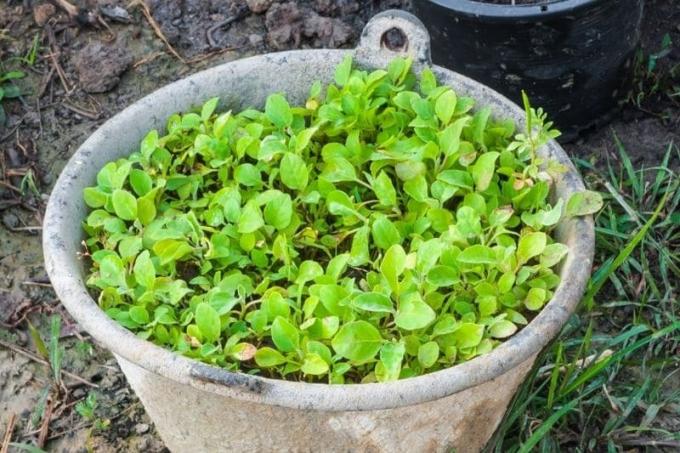
It is inexpensive, large and versatile. Many people even use the mortar bucket as a pot for their plants. It may still work for flowers. But are fruits and vegetables grown in it really harmless to health?
In a nutshell
- Mortar buckets made of PP (polypropylene) and PE (polyethylene) are harmless
- new bucket can smell unpleasant at first
- Rinse the bucket several times and let it evaporate outdoors for 3 to 4 days
- only use tubs that are in perfect condition, sort out damaged and porous specimens
- Mortar bucket made of PVC is not food safe, emits carcinogenic substances
Table of Contents
- Mortar bucket made of PE
- PP mortar bucket
- PVC mortar bucket
- Prepare planter
- Concerns about mortar buckets
- frequently asked Questions
Mortar bucket made of PE
PE stands for the plastic polyethylene. This fabric falls under the food safe category. It is the most used plastic in this country. In the food industry, it comes as a main ingredient from
- yogurt cups
- freezer bags
- various food packaging
often even in direct contact with food. Since the original purpose of a mortar bucket has nothing to do with food, the symbol for food safety (glass and fork symbol) is of course not attached to it. But even without this label, according to current knowledge, it is considered harmless for the cultivation of edible plants.

A notice: Plasticizers are sometimes added to the PE. It may not always be possible to determine whether a particular mortar bucket is affected.
PP mortar bucket
Also PP what for polypropylene is a substance that is often used in industry. It is used, for example, for food packaging. Since no plasticizers are used in the production of PP, this plastic is considered to be less harmful than other plastics. In addition, polyethylene is easy to recycle, so that the environment is less polluted with waste. Thus, mortar tubs made of PP can also be used as planters.
A notice: New mortar buckets often smell unpleasantly of plastic. But don't worry, the smell is due to the manufacturing process and will soon dissipate.
PVC mortar bucket
PVC was used extensively in the past. It is now known that the material can release carcinogenic substances. Mortar buckets are rarely offered in PVC, but they do exist. No edible plants should be grown in them.
Tip: Sometimes the item description under manufacturing material only contains the collective term "plastic". If it is not possible to subsequently identify the material beyond doubt, it is better not to buy the mortar bucket as a planter.
Prepare planter

To get rid of an unpleasant odor, the bucket should be properly cleaned before planting. Any adhering foreign matter from the production process, which may are a health hazard eliminated.
- Clean the bucket with soapy water and a soft cloth
- Rinse thoroughly with clear water several times
- leave to dry out in the fresh air (approx. 3 to 4 days)
- repeat the process if the smell remains
Tip: Before using the mortar bucket potatoes, tomatoes etc., be sure to drill a few larger holes in the ground. This ensures that no irrigation water can accumulate.
Concerns about mortar buckets
Even if PP and PE mortar tubs can be used for growing vegetables and fruit, they are not unreservedly recommended. Planted mortar tubs are placed in full sun to give plants light and warmth. The plastics are decomposed by the sun. Although the black coloring makes the material UV-resistant, it cannot be completely ruled out that after years, microparticles become detached and, through irrigation water, get into the potting soil and finally into the fruit reach. For this reason, you should really only use buckets that are in mint condition and in perfect condition.

Tip: As soon as you notice a change in texture in a mortar bucket, such as porosity or Color change, you should stop using it as a planter as a precaution, or at least only ornamental flowers plant.
frequently asked Questions
If a mortar bucket is made of PP or PE, no foil is necessary. Also keep in mind that not all films are automatically food safe. They can also be made of questionable plastics.
In principle, mortar buckets are suitable for all types of vegetables and fruit. But they have proven their worth above all for potatoes and tomatoes. The ratio of space used and yield is optimal here.
Potato tubers grow in the ground. One or the other tuber will therefore come into direct contact with the bucket. Before cooking, peel the potatoes or wash them thoroughly with a vegetable brush. This is how you remove any adhering substances that come from the bucket material.



